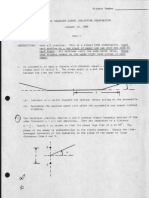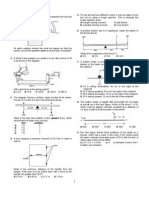UCVTS AIT Physics
UCVTS AIT Physics
Uploaded by
Arsalan Ahmed UsmaniCopyright:
Available Formats
UCVTS AIT Physics
UCVTS AIT Physics
Uploaded by
Arsalan Ahmed UsmaniOriginal Title
Copyright
Available Formats
Share this document
Did you find this document useful?
Is this content inappropriate?
Copyright:
Available Formats
UCVTS AIT Physics
UCVTS AIT Physics
Uploaded by
Arsalan Ahmed UsmaniCopyright:
Available Formats
Kinematics
UCVTS AIT Physics
Kinematics
• Kinematics
– the branch of mechanics that deals with the study of the motion of
objects without regard to the forces that cause the motion
• Displacement
– A vector that points from an object’s initial position (Xo) to its
final position (X) and has a magnitude equal to the shortest
distance between the 2 positions
UCVTS AIT Physics
Vector Example
• A particle travels from
A to B along the path
shown by the dotted red
line
– This is the distance
traveled and is a scalar
• The displacement is the
solid line from A to B
– The displacement is
independent of the path
taken between the two
points
– Displacement is a vector
UCVTS AIT Physics
Kinematics
• Kinematics in 1 Dimension
– We live in a 3-dimensional world, so why bother analyzing 1-dimensional situations?
Well, because any translational (straight-line, as opposed to rotational) motion
problem can be separated into one or more 1-dimensional problems. Problems are
often analyzed this way in physics (and remember throughout your future career;
a complex problem can often be reduced to a series of simpler problems).
– The first step in solving a kinematics problem is to set up a coordinate system. This
defines an origin (a starting point) as well as positive and negative directions. We'll
also need to distinguish between scalars and vectors (which we have done already last
week….remember? I know you do…). A scalar is something that has only a magnitude,
like area or temperature, while a vector has both a magnitude and a direction, like
displacement or velocity.
– In analyzing the motion of objects, there are four basic parameters to keep track of.
These are
• time (t)
• displacement (x or y)
• velocity (v)
• acceleration (a).
• Time is a scalar, while the other three are vectors. In 1 dimension,
however, it's difficult to see the difference between a scalar and a
vector. The difference will be more obvious in 2 dimensions.
UCVTS AIT Physics
Kinematics
• Kinematics in 1 Dimension
– (CJ6 Section 2.1) Displacement
– The displacement represents the distance traveled, but it is a vector, so it also gives the direction.
If you start in a particular spot and then move north 5 meters from where you started, your
displacement is 5 m north. If you then turn around and go back, with a displacement of 5 m south,
you would have traveled a total distance of 10 m, but your net displacement is zero, because you're
back where you started. Displacement is the difference between your final position (x) and your
starting point (xi) : It is a vector that points from an object’s initial position to it’s final
position.
– (CJ6 Section 2.2) Speed and Velocity
– Imagine that on your way to class one morning, you leave home on time, and you walk at 3 m/s east
towards campus. After exactly one minute you realize that you've left your physics assignment at
home, so you turn around and run, at 6 m/s, back to get it. You're running twice as fast as you
walked, so it takes half as long (30 seconds) to get home again.
– There are several ways to analyze those 90 seconds between the time you left home and the time
you arrived back again. One number to calculate is your average speed, which is defined as the total
distance covered divided by the time. If you walked for 60 seconds at 3 m/s, you covered 180 m. You
covered the same distance on the way back, so you went 360 m in 90 seconds.
– Average speed = distance / elapsed time = 360 / 90 = 4 m/s.
– The average velocity, on the other hand, is given by:
x
average velocity : v
t
• In this case, your average velocity for the round trip is zero, because you're back where you started so the
displacement is zero
distance
avg speed
total time
r
x
average velocity : v x is the displacement vector , v has same direction as x
t
r
r v
instantaneous velocity v t is small
t
r
v
average acceleration : a v is a vector
t
UCVTS AIT Physics
Kinematics
• Acceleration
– An object accelerates whenever its velocity changes. Going back to the example we
used above, let's say instead of instantly breaking into a run the moment you turned
around:
• you steadily increased your velocity from 3m/s west to 6 m/s west in a 10 second period.
– If your velocity increased at a constant rate, you experienced a constant acceleration of 0.3 m/s per
second (or, 0.3 m/s2).
– We can figure out the average velocity during this time. If the acceleration is
constant, which it is in this case, then the average velocity is simply the average of
the initial and final velocities. The average of 3 m/s west and 6 m/s west is 4.5 m/s
west. This average velocity can then be used to calculate the distance you traveled
during your acceleration period, which was 10 seconds long. The distance is simply the
average velocity multiplied by the time interval, so 45 m.
– Similar to the way the average velocity is related to the displacement, the average
acceleration is related to the change in velocity: the average acceleration is the
change in velocity over the time interval (in this case a change in velocity of 3 m/s in a
time interval of 10 seconds). The instantaneous acceleration is given by:
v
a
t
• As with the instantaneous velocity, the time interval is very small (unless the acceleration is
constant, and then the time interval can be as big as we feel like making it).
– On the way out, you traveled at a constant velocity, so your acceleration was zero. On
the trip back your instantaneous acceleration was 0.3 m/s2 for the first 10 seconds,
and then zero after that as you maintained your top speed. Just as you arrived back
at your front door, your instantaneous acceleration would be negative, because
your velocity drops from 6 m/s west to zero in a small time interval. If you took
2 seconds to come to a stop, your acceleration is -6 / 2 = -3 m/s2.
UCVTS AIT Physics
Kinematics
• Equations of Kinematics when Acceleration is Constant
– When the acceleration of an object is constant, calculations of the distance traveled
by an object, the velocity it's traveling at a particular time, and/or the time it takes
to reach a particular velocity or go a particular distance, are simplified. There are
four equations that can be used to relate the different variables, so that knowing
some of the variables allows the others to be determined.
– Note that the equations apply under these conditions:
– the acceleration is constant
– the motion is measured from t = 0
– the equations are vector equations, but the variables are not normally written in bold
letters. The fact that they are vectors comes in, however, with positive and negative
signs.
– The equations are:
v v0 at
1
x x0 (v0 v)t
2
1 2
x x0 v0t at
2
v 2 v02 2a ( x x0 )
UCVTS AIT Physics
Kinematics
• Applications of the Equations of Kinetics
– 1. Make a drawing to represent the situation being studied
– 2. Decide which directions are positive and negative
– 3. Make a chart and write down all known values and what the question is asking for.
– 4. Verify that that the given information contains at least 3 of the 5 kinetic variables.
– 5. If the motion of the object is divided into segments, remember that the final
velocity of one segment is the initial velocity of the next segment.
– Do Example 4 problem in CJ6 page 31
– Do Example 6 Problem in CJ6 on page 35
UCVTS AIT Physics
Kinematics
• Applications of the Equations of Kinetics
– Do Example 6 Problem in CJ6 on page 35
• Find the displacement of the jet when v=62m/s
UCVTS AIT Physics
Kinematics
• Freely Falling Bodies (Free Fall)
– Objects falling straight down under the influence of gravity are excellent examples of objects
traveling at constant acceleration in one dimension. This also applies to anything you throw straight
up in the air which, because of the constant acceleration downwards, will rise until the velocity drops
to zero and then will fall back down again.
– The acceleration experienced by a dropped or thrown object while it is in flight comes from the
gravitational force exerted on the object by the Earth. If we're dealing with objects at the Earth's
surface, which we usually are, we call this acceleration g, which has a value of 9.8 m/s2. This value is
determined by three things: the mass of the Earth, the radius of the Earth, and a number called the
universal gravitational constant.
– A typical one-dimensional free fall question (free fall meaning that the only acceleration we have to
worry about is g) might go like this.
– You throw a ball straight up. It leaves your hand at 12.0 m/s.
• How high does it go?
• If, when the ball is on the way down, you catch it at the same height at which you let it go, how long was it in flight?
• How fast is it traveling when you catch it?
– Origin = height at which it leaves your hand
Positive direction = up
– (a) At the very top of its flight, the ball has an instantaneous velocity of zero. We can plug v = 0 into
the equation:
– This gives: 0 = 144 + 2 (-9.8) x
– Solving for x gives x = 7.35 m, so the ball goes 7.35 m high.
• (b) To analyze the rest of the problem, it's helpful to remember that the down half of the trip is a mirror image of
the up half. In other words, if, while going up, the ball passes through a particular height at a particular velocity (2
m/s up, for example), on its way down it will pass through that height at the same speed, with its velocity directed
down rather than up. This means that the up half of the trip takes the same time as the down half of the trip, so
we could just figure out how long it takes to reach its maximum height, and then double that to get the total time.
• Another way to do it is simply to plug x = 0 into the equation:
• This gives 0 = 0 + 12 t - 4.9 t2
• A factor of t can be canceled out of both terms, leaving:
• 0 = 12 - 4.9 t, which gives a time of t = 12 / 4.9 = 2.45 s.
– (c) The answer for part (c) has to be 12 m/s down, because of the mirror-image relationship between
the up half of the flight and the down half. We could also figure it out using the equation:
– v = vo + a t which gives:
• v = 12 - 9.8 (2.45) = -12 m/s.
UCVTS AIT Physics
Kinematics
• Freely Falling Bodies (Free Fall)
– Do Example 12 (CJ6 page 41)
UCVTS AIT Physics
Kinematics
• 2D Kinematics
– Motion can be described in terms of time t and the x and y components of the
displacement, acceleration and initial and final velocity vectors.
– Treat the x and y motion separately (each occurs as if the other was not happening!)
• Combine x and y motions at the end of the problem using Pythagorean Theorem and
trigonometry
x component y component
x displacement y
ax acceleration ay
vf x final velocity vf y
v0 x initial velocity v0 y
t elapsed time t
v f x v0 x ax t v f y v0 y a y t
1 1
x (v0 x v f x )t y (v0 y v f y )t
2 2
1 1
x v0 xt ax t 2 y v0 y t a y t 2
2 2
v f 2x v0 x 2 2ax x v f 2y v0 y 2 2a y y
UCVTS AIT Physics
Kinematics
• Projectile Motion
– Idealized kind of motion that occurs when a moving object experiences only the acceleration due to
gravity, acting vertically downward. We will use this type of motion as the basis for our study of 2D
Kinematics.
– For the trajectory of projectile motion, ay has a magnitude of 9.8m/s2 in the x direction there is no
acceleration (ax=0)
– The x motion takes place as if the y motion isn't happening, and the y motion takes place
independent of whatever is happening in the x direction.
– One good example of this is the case of two objects (e.g., baseballs) which are released at the
same time. One is dropped so it falls straight down; the other is thrown horizontally. As long
as they start at the same height, both objects will hit the ground at the same time, no matter
how fast the second one is thrown.
• Do example 2 (page 60) and example 3 (page 62)
UCVTS AIT Physics
UCVTS AIT Physics
Physics
• Problem Solving Steps
– 1. Don’t Panic! Every problem has a solution.
• Well, at least the problems this year in Physics
– 2. READ the problem, READ the problem!
– 3. Construct an informative diagram of the physical situation
(sketch).
– 4. Identify and list the given information in variable form
(make a table of values)
– 5. Identify and list the unknown information in variable
form.
– 6. Identify and list the equation which will be used to
determine the unknown information from the known
variables.
– 7. Substitute known values into the equation and use
appropriate algebraic steps to solve for the unknown
• or solve for the unknown variable first and then substitute
known values (this is generally preferable and easier)
– 8. Check your answer to ensure that it is reasonable and
mathematically correct (include UNITS in you solution and
final answer)
UCVTS AIT Physics
You might also like
- Sizing Electric Motors For Mobile RoboticsDocument35 pagesSizing Electric Motors For Mobile Roboticsanon-29348592% (13)
- 6th Central Pay Commission Salary CalculatorDocument15 pages6th Central Pay Commission Salary Calculatorrakhonde100% (436)
- Dynamics of Rigid BodiesDocument74 pagesDynamics of Rigid BodiesArah Louise Apostol100% (1)
- AlternatorsDocument42 pagesAlternatorsArsalan Ahmed Usmani100% (3)
- Teaching A2 Chemistry Practical SkillsDocument149 pagesTeaching A2 Chemistry Practical SkillsArsalan Ahmed Usmani88% (24)
- Ch3 Review QuestionsDocument15 pagesCh3 Review Questionsave estillerNo ratings yet
- Freshman Physics Formula SheetDocument6 pagesFreshman Physics Formula SheetMickey Boy83% (6)
- Electrochemistry Part 1Document35 pagesElectrochemistry Part 1ABHINAVNo ratings yet
- 6185-Revision Test 1 Class XII Physics Dec 16Document5 pages6185-Revision Test 1 Class XII Physics Dec 16Rehan AhmadNo ratings yet
- Differentiation Explained (Little Mathematics Library) - Mir (1977)Document65 pagesDifferentiation Explained (Little Mathematics Library) - Mir (1977)Aashish KohliNo ratings yet
- Chemistry - Haloalkanes and HaloarenesDocument34 pagesChemistry - Haloalkanes and HaloarenesKaran VermaNo ratings yet
- 10 HALOALKANES AND HALOARENES 31 With Not All Ncert, But Pyq 34Document34 pages10 HALOALKANES AND HALOARENES 31 With Not All Ncert, But Pyq 34Aryan POONIANo ratings yet
- Electrochemistry 494 PDFDocument55 pagesElectrochemistry 494 PDFHarsh SaxenaNo ratings yet
- Answer Solution NEET-2023 (Code-E6) FinalDocument74 pagesAnswer Solution NEET-2023 (Code-E6) FinalParamjit ChandNo ratings yet
- Jee Main 2022 26 July Morning Shift Question Paper With Solutions PDFDocument26 pagesJee Main 2022 26 July Morning Shift Question Paper With Solutions PDFALEKHYA KANCHIBHATLANo ratings yet
- NCERT Exemplar For Class 11 Physics Chapter 3 - Motion in A Straight Line (Book Solutions)Document40 pagesNCERT Exemplar For Class 11 Physics Chapter 3 - Motion in A Straight Line (Book Solutions)Sanjana MehtaNo ratings yet
- Study Material: Downloaded From VedantuDocument26 pagesStudy Material: Downloaded From VedantukamalNo ratings yet
- BOW Guru Antra Goal: Anand PrakashDocument25 pagesBOW Guru Antra Goal: Anand PrakashAnanya AgrawalNo ratings yet
- 58d4dc0ce4b0ee8fadafdee8 5e9a07969e955c217f3275f6 1609736195187Document27 pages58d4dc0ce4b0ee8fadafdee8 5e9a07969e955c217f3275f6 1609736195187Pratabidya MahapatraNo ratings yet
- Neet 2019 R3 PDFDocument31 pagesNeet 2019 R3 PDFij_britoNo ratings yet
- XI-NEET-Physics M-1 Final BookletDocument170 pagesXI-NEET-Physics M-1 Final Bookletgramatalia1913No ratings yet
- Chapter5 VectorsDocument23 pagesChapter5 VectorsFaiz RusliNo ratings yet
- Study Material: Free Master Class SeriesDocument41 pagesStudy Material: Free Master Class SeriesSayantan ChakrabortyNo ratings yet
- Work, Energy & Power NumericalsDocument9 pagesWork, Energy & Power NumericalsSiddhartha Mukherjee100% (1)
- JEE Main 2021 26 Feb (Shift 2)Document39 pagesJEE Main 2021 26 Feb (Shift 2)Siddharth AndhaleNo ratings yet
- Trignometric Identities Wk-3 Class Xith Maths (Work-Sheet)Document1 pageTrignometric Identities Wk-3 Class Xith Maths (Work-Sheet)Akshat JoshiNo ratings yet
- Study Material: Free Master Class SeriesDocument29 pagesStudy Material: Free Master Class Seriesnikkesh ganesanNo ratings yet
- Study Material: Free Master Class SeriesDocument27 pagesStudy Material: Free Master Class SeriesAman KumarNo ratings yet
- Matrix Algebra For Beginners, Part I Matrices, Determinants, InversesDocument16 pagesMatrix Algebra For Beginners, Part I Matrices, Determinants, InversesAbraxas LuchenkoNo ratings yet
- 13 Electrostatics PDFDocument133 pages13 Electrostatics PDFdomahe7121No ratings yet
- Class 11 - Physics - Thermal Properties of MatterDocument35 pagesClass 11 - Physics - Thermal Properties of MatterZekroMNo ratings yet
- Grade 10 Physics Chapter 3 Revision Problems - Answer Key: Multiple Choice Questions. Q1Document6 pagesGrade 10 Physics Chapter 3 Revision Problems - Answer Key: Multiple Choice Questions. Q1NONO0% (1)
- CBSE Class 11 Physics Chapter 3 - Motion in A Straight Line Important Questions 2022-23Document33 pagesCBSE Class 11 Physics Chapter 3 - Motion in A Straight Line Important Questions 2022-23Arpan SainiNo ratings yet
- Physics Model Test PaperDocument23 pagesPhysics Model Test PaperShouryaNo ratings yet
- Ionic+Equilibrium VEDANTUDocument295 pagesIonic+Equilibrium VEDANTUKing GokulNo ratings yet
- 4309 Topper 21 101 3 4 122 Motion in A Straight Line Up201611021148 1478067495 4997Document9 pages4309 Topper 21 101 3 4 122 Motion in A Straight Line Up201611021148 1478067495 4997sadhu associatesNo ratings yet
- Neet (Aipmt) PDFDocument114 pagesNeet (Aipmt) PDFPallav JainNo ratings yet
- 4.2.1 Slope of The Tangent and Normal: F y y X PDocument17 pages4.2.1 Slope of The Tangent and Normal: F y y X PAnkit Kumar Thakur100% (1)
- Chemistry: Video Lectures Questions and Answers Problems Discussion (NEET, JEE)Document22 pagesChemistry: Video Lectures Questions and Answers Problems Discussion (NEET, JEE)chemistry pageNo ratings yet
- Matriculation Physics Magnetic FieldDocument112 pagesMatriculation Physics Magnetic FieldMaslinda Mat SharifNo ratings yet
- PhyssciencesDocument21 pagesPhyssciencesKhaled AlhajNo ratings yet
- Lab Manual - Physics PDFDocument69 pagesLab Manual - Physics PDFbookdigitNo ratings yet
- Sample PDF of Neet Ug 10 Full Syllabus Mock Test Book Sample ContentDocument23 pagesSample PDF of Neet Ug 10 Full Syllabus Mock Test Book Sample Contentshettyanushka2006No ratings yet
- 5 Work, Energy and PowerDocument39 pages5 Work, Energy and PowerGeanelle BonilloNo ratings yet
- JEE Main Coordination Compounds Important QuestionsDocument17 pagesJEE Main Coordination Compounds Important Questionsixgreenprakharanjana16No ratings yet
- CirclesDocument17 pagesCirclesTrivendra Dehariya Of Class 9th ANo ratings yet
- Test Your Preparation For NEET 2021: Anand PrakashDocument68 pagesTest Your Preparation For NEET 2021: Anand PrakashAbhishek PantheeNo ratings yet
- Class 11 - Biology - Respiration in PlantsDocument13 pagesClass 11 - Biology - Respiration in PlantsDivyansheeNo ratings yet
- Vedantu Ncert PDF SheetDocument13 pagesVedantu Ncert PDF SheetKshreeNo ratings yet
- Statistical Mechanics Work Sheet 12Document8 pagesStatistical Mechanics Work Sheet 12davididosa40No ratings yet
- APPhysicsVectors and2DMotionDocument17 pagesAPPhysicsVectors and2DMotionBacillus SubtilisNo ratings yet
- CH 29 Tutorials Problems - With SolutionsDocument5 pagesCH 29 Tutorials Problems - With Solutionsshihabsultan100% (1)
- CMO 88 S. 2017 BS Electrical EngineeringDocument112 pagesCMO 88 S. 2017 BS Electrical EngineeringEstelita BantolinoNo ratings yet
- Chapter #26-Capacitance & DielectricsDocument42 pagesChapter #26-Capacitance & DielectricsJi Hoon MyeongNo ratings yet
- Physics Project Class 12Document13 pagesPhysics Project Class 12vinayNo ratings yet
- Biological Classification VedDocument13 pagesBiological Classification VedTanisha VarshneyNo ratings yet
- Electricity and MagnetismDocument15 pagesElectricity and MagnetismSerge Andre UsonNo ratings yet
- QualifyingExamProblemPhysicsUnivOfPrude 1980 2008 PDFDocument518 pagesQualifyingExamProblemPhysicsUnivOfPrude 1980 2008 PDFkajariNo ratings yet
- IIT JAM Physics 2022 - Question PaperDocument22 pagesIIT JAM Physics 2022 - Question PaperAakash DwivediNo ratings yet
- Bridge Course Physics For B.TecDocument156 pagesBridge Course Physics For B.TecAmanjeet PanghalNo ratings yet
- Physics Details of Courses January 2019: PHY320 Physics Lab VDocument13 pagesPhysics Details of Courses January 2019: PHY320 Physics Lab VAdwinPittNo ratings yet
- Unit 11 Moments 1Document5 pagesUnit 11 Moments 1Kesha DilworthNo ratings yet
- Jee Advanced PaperDocument33 pagesJee Advanced PaperKushagra SagarNo ratings yet
- Unit 2 KinematicsDocument94 pagesUnit 2 KinematicsOsama AbdullahNo ratings yet
- Lecture 1Document45 pagesLecture 1Labib KhanNo ratings yet
- CCNA PresentationDocument584 pagesCCNA Presentationwantknow100% (6)
- Electrical MeasurementsDocument504 pagesElectrical MeasurementsArsalan Ahmed Usmani100% (3)
- Welding Inspection PresentationDocument46 pagesWelding Inspection PresentationChristo Van Den Heever100% (1)
- Noise and Operational Amplifier CircuitsDocument10 pagesNoise and Operational Amplifier CircuitsArsalan Ahmed UsmaniNo ratings yet
- Car PlansDocument11 pagesCar Planslaurlos100% (2)
- Simple Science ExperimentsDocument59 pagesSimple Science ExperimentsArsalan Ahmed Usmani100% (4)
- ParaphrasingDocument2 pagesParaphrasingArsalan Ahmed Usmani78% (9)
- Maths For ScienceDocument433 pagesMaths For ScienceArsalan Ahmed Usmani100% (2)
- Creative Time - Manage The Mundane - Create The ExtraordinaryDocument32 pagesCreative Time - Manage The Mundane - Create The ExtraordinarySolomon100% (3)
- Physics FormulasDocument108 pagesPhysics FormulasArsalan Ahmed Usmani100% (3)
- Holy Prophet Muhammad S.A.W.S Life Style, Islamic Life Style, An Introduction To IslamDocument25 pagesHoly Prophet Muhammad S.A.W.S Life Style, Islamic Life Style, An Introduction To IslamHassanNo ratings yet
- Teaching A2 Biology Practical SkillsDocument108 pagesTeaching A2 Biology Practical SkillsArsalan Ahmed Usmani89% (18)
- Teaching A2 Physics Practical SkillsDocument90 pagesTeaching A2 Physics Practical SkillsArsalan Ahmed Usmani100% (13)
- Teaching AS Physics Practical SkillsDocument86 pagesTeaching AS Physics Practical SkillsArsalan Ahmed Usmani95% (22)
- Imam NawawiDocument892 pagesImam NawawiIrfan ArnavutiiNo ratings yet
- Rotational Kinematics Worksheet PacketDocument12 pagesRotational Kinematics Worksheet PacketElias MaciasNo ratings yet
- Experiment No 6 Rolling Disc On Inclined Plane Objective: ApparatusDocument5 pagesExperiment No 6 Rolling Disc On Inclined Plane Objective: ApparatusAliNo ratings yet
- Chapter 1: Electric Charge and Coulomb Law: EP 106 General Physics IIDocument5 pagesChapter 1: Electric Charge and Coulomb Law: EP 106 General Physics IIMouayed ZeadanNo ratings yet
- Physics A Level Formula Sheet 2Document4 pagesPhysics A Level Formula Sheet 2Ahmad HussainNo ratings yet
- Radioisotope ProductionDocument21 pagesRadioisotope ProductionrakicbgNo ratings yet
- FISICACALCDocument26 pagesFISICACALCMaria Sofia100% (1)
- Chapter 1 PDFDocument13 pagesChapter 1 PDFR Yone OoNo ratings yet
- SWM 01 Motion SimulationDocument18 pagesSWM 01 Motion SimulationshNo ratings yet
- S-Series Single Stage Gear MotorsDocument138 pagesS-Series Single Stage Gear MotorssirabhijeetNo ratings yet
- Newston's Laws of MotionDocument4 pagesNewston's Laws of MotionkenNo ratings yet
- Motion in 1 D - dpp3Document8 pagesMotion in 1 D - dpp3Shashwat KhuranaNo ratings yet
- Week 4 Kinetics of Particles (Before Class)Document36 pagesWeek 4 Kinetics of Particles (Before Class)陳台No ratings yet
- Kinematics of Particles Plane Curvilinear MotionDocument16 pagesKinematics of Particles Plane Curvilinear Motionson gokuNo ratings yet
- April 2011 2008Document7 pagesApril 2011 2008Piyush BhandariNo ratings yet
- Answer Drill Problems D2.1/p.31 and D2.2/p.35. Submit in PDFDocument2 pagesAnswer Drill Problems D2.1/p.31 and D2.2/p.35. Submit in PDFAlven Ballecer50% (2)
- 11 Physics Chapter 8 Assignment 1Document1 page11 Physics Chapter 8 Assignment 1nellai kumarNo ratings yet
- 15e303 Electromagnetic TheoryDocument2 pages15e303 Electromagnetic TheoryLatha KandasamyNo ratings yet
- P4gravitation 2016Document71 pagesP4gravitation 2016Abdur RehmanNo ratings yet
- Phys101l - A6 - Group 1 - E103 - E104 - 3Q2122Document7 pagesPhys101l - A6 - Group 1 - E103 - E104 - 3Q2122Jocel Erick P. LimNo ratings yet
- Solution To Tut 3 PDFDocument11 pagesSolution To Tut 3 PDFkalirajgurusamyNo ratings yet
- Work Energy and Power PDFDocument16 pagesWork Energy and Power PDFjonelle27No ratings yet
- May 2000 - PI PDFDocument16 pagesMay 2000 - PI PDFAnan BarghouthyNo ratings yet
- 4.3.2 Circular MotionDocument8 pages4.3.2 Circular MotionMozammel AnowarNo ratings yet
- 01 Static ElectricityDocument31 pages01 Static ElectricitySkyZz CSGONo ratings yet
- Work Energy and PowerDocument31 pagesWork Energy and PowerRaichal P BijuNo ratings yet
- Conservative and Non Conservative Forces, Conservation of EnergyDocument22 pagesConservative and Non Conservative Forces, Conservation of EnergyMa Cristina VelascoNo ratings yet











































































































